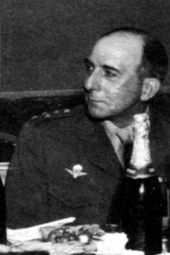Battle of the Day River
| Battle of the Day River | |||||||||
|---|---|---|---|---|---|---|---|---|---|
| Part of the First Indochina War | |||||||||
 de Lattre, commander of the French forces, who lost his only son in the battle. | |||||||||
| |||||||||
| Belligerents | |||||||||
|
| |||||||||
| Commanders and leaders | |||||||||
| Jean de Lattre de Tassigny | Vo Nguyen Giap | ||||||||
| Strength | |||||||||
| 3 regimental combat teams, 2 para battalions, 1 dinassaut | Three divisions (only TD 64 of DD 320 took part in action according to Gras[1]) | ||||||||
| Casualties and losses | |||||||||
| 107 killed, 189 mia, 289 wounded[2] | 1,000 captured, 9,000 killed or wounded. French 1159 killed, 154 prisoners and 287 wounded[3] | ||||||||
The Battle of the Day River (French: bataille du Day) took place between late May and early June 1951, around the Day River Delta in the Gulf of Tonkin. Part of the First Indochina War, the battle was the first conventional campaign of Vo Nguyen Giap, and saw his Viet Minh forces tackle the Catholic-dominated region of the Delta in order to break its resistance to Viet Minh infiltration. On the back of two defeats at similar ventures through March and April that year, Giap led three divisions in a pattern of guerrilla and diversion attacks on Ninh Binh, Nam Dinh, Phu Ly and Phat Diem beginning on May 28 which saw the destruction of commando François, a naval commando. The French army, under Jean de Lattre de Tassigny, who lost his son in the first day of the battle at Ninh Binh, mobilised three mobile groups (groupements mobiles, similar to regimental combat teams) and two paratrooper battalions as well as one dinassaut,[4] and the ebb and flow of captured and retaken positions continued until Giap's supply lines were cut around June 6. His forces, moving in large numbers and during daylight, were vulnerable to French firepower and to French ground forces supported by friendly local militia. The Viet Minh were forced into withdrawing between June 10 and June 18, leaving 1,000 prisoners to the French and 9,000 casualties.[5][6]
Notes
References
- Fall, Bernard B. (1966). Hell in a Very Small Place. The Siege of Dien Bien Phu. London: Da Capo Press. ISBN 978-0-306-81157-9.
- Fall, Bernard B. (1961). Street Without Joy. The French Debacle in Indochina. New York: Stackpole Military History. ISBN 978-0-8117-3236-9.
- Fall, Bernard B. (1967). The Two Vietnams. A Political and Military Analysis (Second Edition ed.). New York: Frederick A. Praeger, Inc.
- Roy, Jules (1963). The Battle of Dien Bien Phu. New York: Carroll and Graf Publishers. ISBN 978-0-7867-0958-8.
- Gras, Yves (1979). Histoire de la Guerre d'Indochine. Paris. ISBN 2-259-00478-4.
- Windrow, Martin (2004). The Last Valley. Dien Bien Phu and the French Defeat in Vietnam. London: Weidenfeld and Nicolson. ISBN 978-0-304-36692-7.
See also
- Battle of Mang Yang pass for the usual composition of a groupement mobile